This article was originally published on The Football Pink. You can subscribe to the magazine in print or digitally here.
Throughout his life Johan Cruyff, with his unique insight and perspective, and of course his brazen attitude and habit of criticising conservatism, was considered to be a rebel – especially on the terraces of the Camp Nou and the streets of Barcelona. Tellingly, after his death, Spanish newspaper Sport published a picture likening Cruyff to Che Guevara.
Videos by VICE
A not-so-famous photo from Cruyff’s time in a Blaugrana shirt shows him in confrontation with two police officers. The photo was taken in 1975, at a match between Barcelona and Malaga, when the officers had come to escort Cruyff off the pitch after he was shown a red card for protesting what he perceived to be repeated wrong decisions by the referee, much to the outrage of the Barcelona faithful. An apocryphal story says that as he walked off the pitch, he took off his captain’s armband (with its red and gold stripes symbolising the flag of Catalonia), looked up at the packed terraces of the Camp Nou and kissed it. To this day, the incident is interpreted as signifying Catalan resistance to dictator Francisco Franco’s government in Madrid.
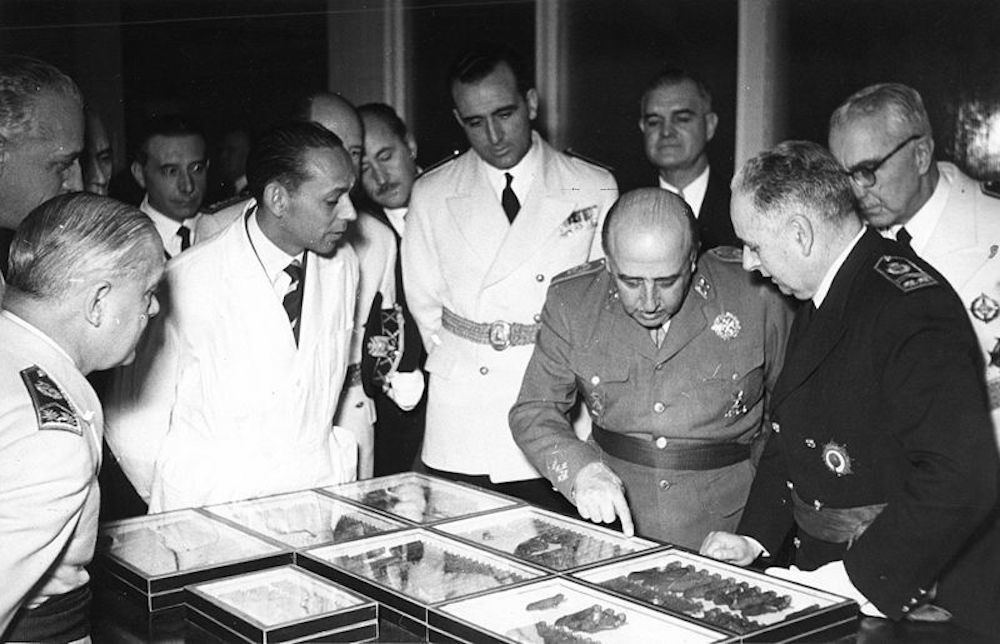
Francisco Franco alongside government officials, 1954 // Via
In 1936, elements of the Spanish armed forces and right-wing conservative groups, backed by Nazi Germany and fascist Italy, led a coup against the elected leftist government of Spain. The right-wing faction sought to establish a centralised government in Madrid and impose a homogenised Castilian identity on all of Spain. Cultural conflicts between the Castilians and the people of Catalonia and the Basque regions which had been brewing since the early 20th century erupted violently. A wave of Left Republicanism swept through Spain and the country was engulfed in a bloody civil war which would last nearly four years. Thousands of volunteers from all over the world would join the Republican cause under the mostly-Comintern run International Brigades. By 1937, however, Madrid had been surrounded by fascist forces and large parts of Catalonia and the Basque country had fallen. In 1939, Spain came under the control of Generalissimo Francisco Franco and the right-wing factions were fused into the dictatorial government in Madrid.
READ MORE: Royalist, Republican, Socialist, Fascist – The Chequered History of the Copa Del Rey
In Catalonia and the Basque provinces, Franco’s forces conducted organised purges of the republicans, and all symbols and traditions of their local identity and culture were banned. The Falangist government was obsessed with how the rest of the world perceived Spain, and football became a tool for propaganda, especially through Real Madrid, who mesmerised the world with their football in the 1950s. Based in the capital, Real fitted well with Franco’s vision of a homogenous, centralised Spain.
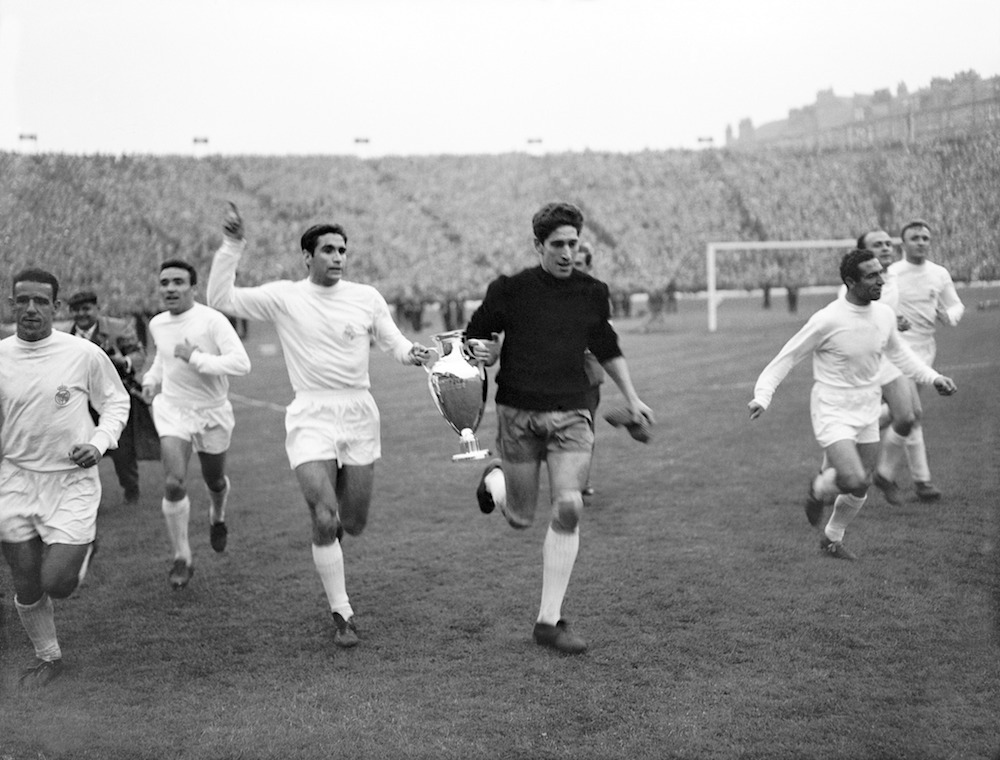
Real Madrid parade the European Cup in 1960, having won it for the fifth consecutive year // PA Images
On the other hand, the Francoist government viewed Barcelona, the club of Catalonia, and the Basque club, Athletic Bilbao, as repositories of republicanism and local identity. It banned the use of non-Castilian languages and imposed strict restrictions on Barcelona and Bilbao, including making them change their names from the Catalonian “Futbol Club Barcelona” and the Basque “Athletic Bilbao” to their Castilian equivalents, “Club de Fútbol Barcelona” and “Atlético Bilbao”.
In 1943, Barcelona, whose president Josep Sunyol had been murdered by Falangists in 1936, faced Real Madrid in the semi-finals of the Copa del Generalissimo. They had won the first leg 3-0. Although nothing was ever proven, a local reporter alleged that the team had been visited by the director of the state police who politely reminded them of the government’s generosity at letting them stay in the country. Barcelona lost the second leg 11-1. Nearly a decade later, on a rainy Sunday in 1951, Barcelona supporters left the Les Corts stadium after a 2-1 win against Santander and every single person opted to walk in the rain rather than take the trams. They were supporting a strike by the tram workers of the city. The Camp Nou soon became the only place where the Catalan people could freely express their cultural identity and speak their native language.
READ MORE: Double Disaster In El Clasico – The Mutual Humiliation Of Barca and Real
Meanwhile on the pitch, Barcelona entered a barren phase in the 1960s and won only a couple of trophies while Real Madrid dominated the domestic league and were a major force in Europe.
During a period of stagnation, one often needs an outsider to shake things up. Enter Johan Cruyff.

PA Images
After captaining Ajax to three consecutive European Cup victories, Cruyff fell out with his club and some of his teammates. Ajax wanted to sell him to Real Madrid but Cruyff forced through a transfer to Barcelona in 1973, to join his former coach and father-figure Rinus Michels who was then manager. For the Catalonians living in those times, Cruyff’s declaration that he didn’t sign for the Madrid club because he would never play for a team which represented Francisco Franco meant more than an indictment of Francoist Spain – it meant that the world’s best footballer knew what a club then languishing at the bottom of the table stood for, and had decided to play for them.
That same season, as Franco supported Madrid from his sickbed, Cruyff led a Barcelona side that swept aside Real Madrid 5-0 at their own ground. Back in Barcelona, thousands poured out into the streets in celebration. A New York Times journalist commenting on the match wrote that Cruyff had done more for Catalonia in 90 minutes than politicians had managed to do in decades of struggle. Languishing second from bottom of the league table when Cruyff joined, Barcelona would go on a 17-game unbeaten run that would see them lift the La Liga trophy for the first time since 1960. While Cruyff played for Barcelona, they did not win anything other than the league title in 1973/74 and the Copa del Rey in 1977/78. However, as historian Jimmy Burns wrote in Barça: A People’s Passion, Cruyff brought flexibility, speed and a “sense of themselves” to the side; with Cruyff they believed they would never lose. For the people of Catalonia, in whose minds the memories of the civil war and the ruthless suppression and purges that followed were still fresh, Cruyff’s confidence and brazen, outspoken attitude both on and off the field was a source of courage.
READ MORE: Heroes of Galicia, Champions of Spain – Remembering Deportivo’s La Liga Triumph
Both as a player and manager, Cruyff would change football forever. In many ways, he was a philosopher, always viewing the game in his own unique way. But to get an idea of why he was always considered a rebel, one must travel back to where Cruyff grew up in his hometown of Amsterdam, a city which philosopher and amateur goalkeeper Albert Camus – who had also fought fascism and colonialism, as a member of the French Resistance in Nazi-occupied France and later as a champion of Algeria’s struggle for independence – had described in his book The Fall as so boring that “for centuries, pipe-smokers have been watching the same rain falling on the same canal.”
Post-war Amsterdam was not the suave, sexy city of sensuality and sin that we recognise today. The Netherlands of those times was very conservative and quite regressive, especially when it came to women’s and workers’ rights. But the situation slowly started to change in the 1960s. With the Beatles being broadcast on TV and the radio, the spirit of revolt had descended on Amsterdam. As David Winner wrote in Brilliant Orange: The Neurotic Genius of Dutch Football: “the old corps were secretive, conservative and reactionary; the new unions were leftist, open and alternative.” Against this oppressive stagnation and the regressive norms of society, there sprang the Provo Movement led by Robert Jasper Grootveld, Rob Stolk and Roel van Duijn.
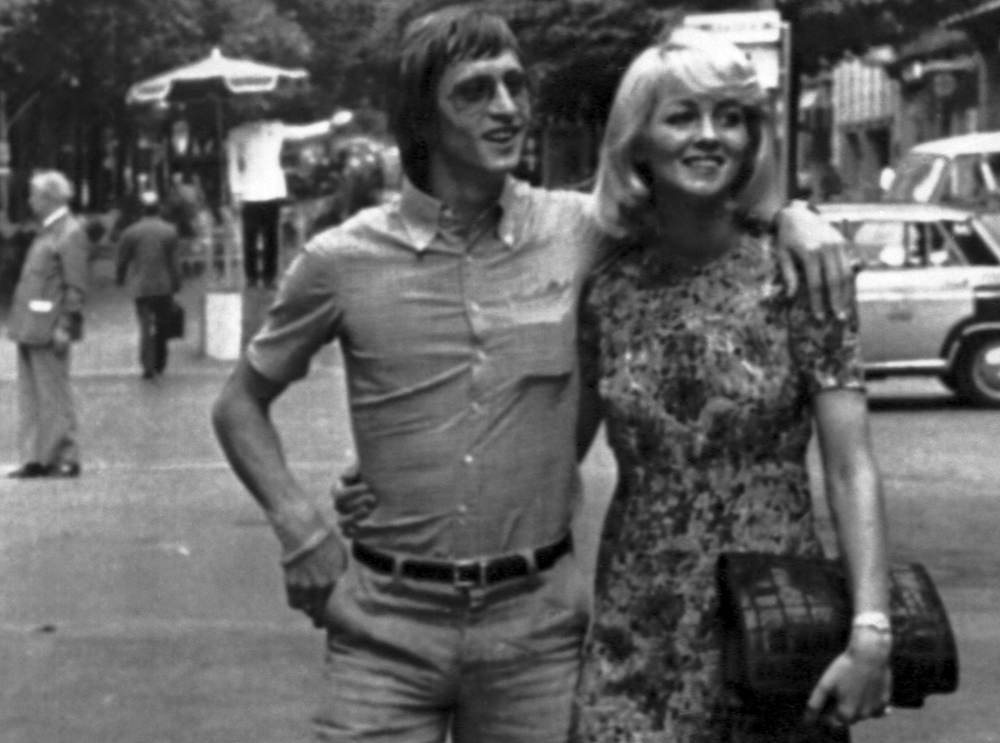
Cruyff and his wife, Danny, in 1973 // PA Images
What started out as an anti-smoking campaign soon became an anarchist counter-culture movement which would change Dutch society forever. The Provo movement expanded isometime later into a leftist, anti-consumerist, anti-capitalist one. Against the Church, monarchy, police and the local government, this ragtag group of artists, activists, and students used playful street insurrection. To break down the image of the moral high ground that these institutions sought to maintain, they would instigate violent responses using non-violent bait.
In 1965, a Provo splinter group, which called itself the Bastaard Group, organised the first anti-Vietnam War demonstration in front of the American embassy in Amsterdam. What began as a sit-in ended with the burning of the American flag and a violent break-up of the demonstration by the police. The peak moment of the Provo movement, however, came during the wedding of Princess Beatrix to the German Claus von Amsberg who had been a member of the Hitler Youth. During the royal procession, Provo activists mingled with the crowd and smuggled in white sugar nitrate smoke bombs. The bombs went off behind the palace as soon as the royal procession started and some activists threw anti-imperialist pamphlets on the royal boat. Unable to discern who the culprits were, the police unleashed unrestrained violence on everyone present. The wedding became a public relations disaster and international condemnation of the police violence inevitably followed.
READ MORE: The Day England’s Footballers Gave The Nazi Salute
In 1966, construction workers held a demonstration to protest against sudden pay cuts, where one of the men died of a heart attack. De Telegraaf wrongly reported that someone had thrown a brick at him which had hit his head and killed him. This report sparked the Amsterdam riots. The communist workers’ unions and the anarchist Provos joined hands and took to the streets. In his book Message to the Rat King, Harry Mulisch, reflecting upon the riots, wrote: “While their parents, seated on refrigerators and washing machines, watched TV with their left eyes, and their cars with their right eyes, a mixer in one hand and the Telegraaf in the other, the kids left Saturday evening for the Spui square.”
What followed was three days of rioting in Amsterdam, with repeated violent clashes between the police and the protestors. Demonstrations were prohibited resulting in the increase in popularity of the Provos who were also now actively protesting against the war in Vietnam. Police brutality increased and by mid-1966, hundreds had been arrested.
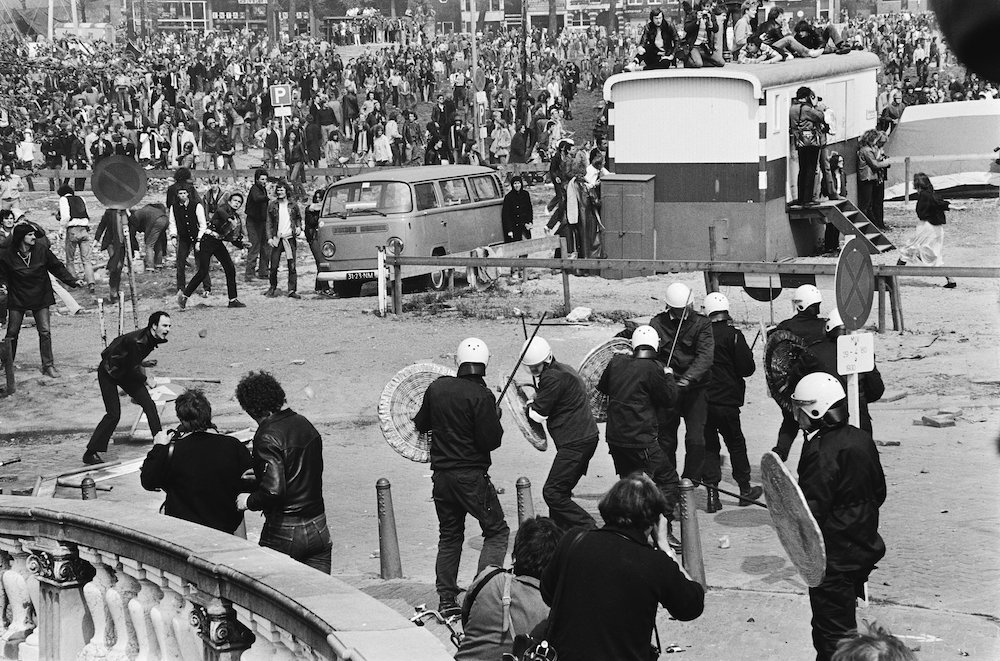
Rioters clash with police in Amsterdam during the wedding of Princess Beatrix // Via
The heavy-handedness of the police had shocked the general public and, under pressure from many leading intellectuals, an official investigation was launched. The Amsterdam chief of police was dismissed and the mayor of Amsterdam was removed from office. Almost two years before the Paris Uprising nearly toppled Charles de Gaulle and rocked the world in 1968, Amsterdam experienced an unprecedented unity between students, workers and activists who carried out a cultural revolution that would change Dutch society for good.
At about this same time, Ajax Amsterdam were slowly but surely breaking away from all the conventional styles of play that were then considered to be the “right” way to play football. With fast and precise passing, fluid movement and overlapping wingers, Ajax, much to the delight of their fans, especially among the post-war generation, were constructing their own unique playing and brushing aside their opponents as they did so. With their philosophy of encouraging individual skill to flourish within a larger framework of the team as a single unit, their itself was revolutionary.
READ MORE: The Golden Age Of The Socialist Manager
Off the pitch and behind the scenes, Dutch footballers were also fighting in favour of professionalising football with the officials of the KNVB. Since all this time football was classified under “amateur” sport, footballers didn’t enjoy the same rights as other workers. Their low pay for playing for club or country meant that most of them also had to do some other work. It also meant that they couldn’t officially organise and form a union.
Making his debut for Ajax in 1964 at the age of 16, Cruyff fast became an influential figure at the club, which in many ways became the face of the new Amsterdam. In an age where playing for the country was supposed to be an honour, Cruyff insisted that footballers get paid properly for their labour; when he found that KNVB officials were insured on foreign trips but players were not, he used his now significant clout to force a change in policy. With his long hair and outspoken criticism of the conservative establishment, Cruyff quickly became a youth icon and a figurehead of the cultural revolution sweeping through the Netherlands.
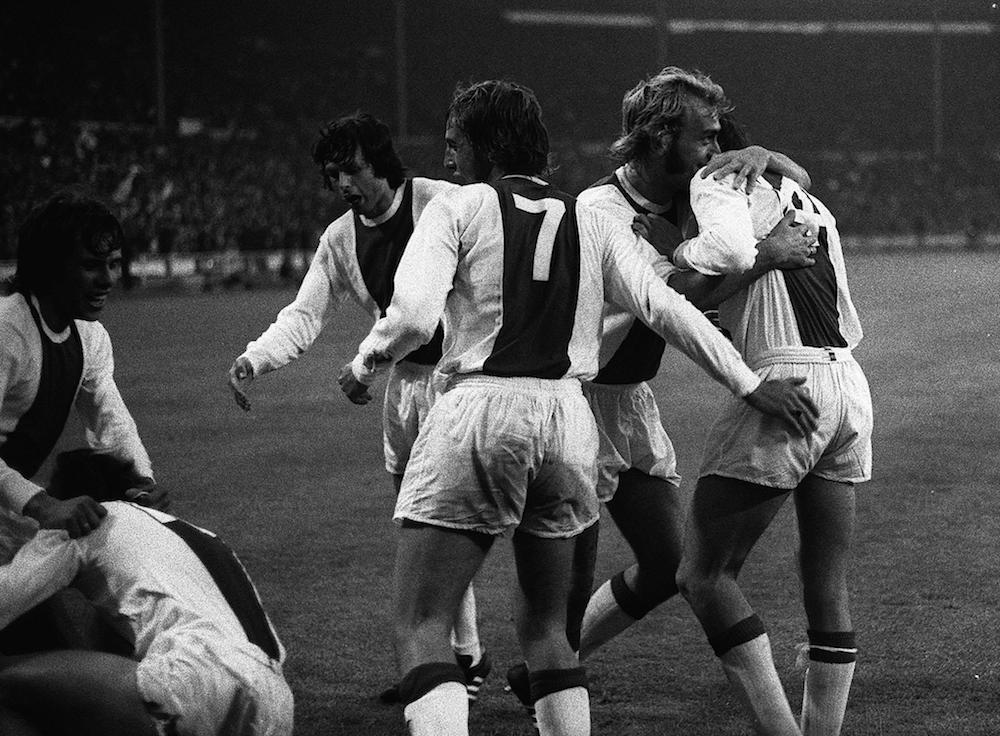
Cruyff celebrates with his Ajax teammates // PA Images
Like any young man growing up in the 1960s, Cruyff influenced – and was also influenced by – a culture of dissent that had developed. After decades of being ruthlessly beaten down in all spheres of life, this fearless, bold and questioning attitude that Cruyff brought to Barcelona was just what Catalonia needed to feel a sense of self-worth and pride again. In a TV documentary, he said: “I was born shortly after the war… and was taught not to just accept anything.” Cruyff adopted Catalan resistance to Francoist Spain as his own fight and in 1974, at a time when Catalan names were banned, Cruyff named his son “Jordi” after the patron saint of Catalonia. When authorities refused to accept the name, he instructed them to register his son as “Johan-Jordi” if they had such a big problem with it. His sheer stubbornness entered Catalan folklore and endeared him to Catalonians. In a documentary about his time in Barcelona, En Un Momento Dado, he says he didn’t know that the name “Jordi” was prohibited at first, but when he realised, he was adamant. In the end, like always, his stubbornness paid off, and this incident would seal his place in Catalan folklore.
In 1977, he and his family were victim to a kidnapping attempt in Barcelona, which influenced his decision to retire from international football. But his sense of what was right remained with him. On being asked why he wouldn’t play in the 1978 World Cup in Argentina, then under the control of a military dictatorship, he had simply said: “How can you play football a thousand metres from a torture centre?”
An excerpt from FC Barcelona’s official anthem, the Cant de Barca reads:
“We’re the blue and claret supporters /
It matters not from where we hail, /
Whether it’s the north or the south, /
Now we all agree, we all agree, one flag unites us in brotherhood.”
As is evident from these lines, one need not be from Catalonia to become Catalan. Much like George Orwell before him, Johan Cruyff was an outsider who had adopted Catalonia’s fight for self-assertion as his own, and Catalonia welcomed him with open arms accordingly. In 2013, as questions of Catalonia’s secession from Spain were raised again in a documentary, The Last Game, Cruyff smiled and said: “We cannot avoid politics. That’s why I had to mix it in a bit.”
Both as a player and later as manager of Barcelona, Cruyff had a tremendous impact on Catalan culture. He came and pulled a people who had been ruthlessly beaten down and suppressed up onto their feet again. He gave them a sense of pride and, above all, hope.
On 24 March 2016, along with the flag of Barcelona at the Camp Nou, the Catalan flag too was lowered and flown at half-mast, as a tribute to Cruyff after he finally succumbed to lung cancer. In his life, Cruyff had paid homage to Catalonia. After his death, all of Catalonia paid homage to her proud, adopted son – the man who had loved her so much.
Note of Thanks: I’d like to thank David Winner and Simon Kuper, whose books introduced me to the wonderfully fascinating world of Dutch football, and most importantly showed me that football, or any other sport for that matter, and politics are not independent and exclusive of each other.
Words: @ShirshoD for @TheFootballPink // Illustration by Michael Atkinson, available here.




